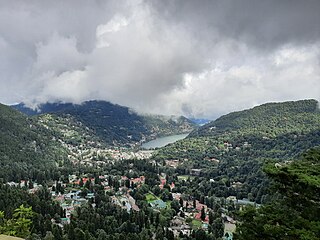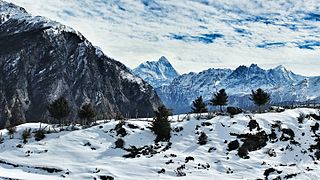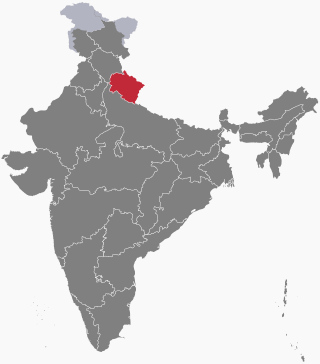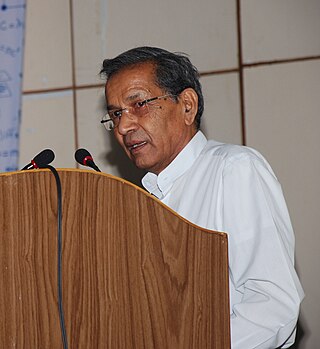
Nainital is a town and headquarters of Nainital district of Kumaon division, Uttarakhand, India. It is the judicial capital of Uttarakhand, the High Court of the state being located there and is the headquarters of an eponymous district. It also houses the Governor of Uttarakhand, who resides in the Raj Bhavan. Nainital was the summer capital of the United Provinces.

Uttarakhand, also known as Uttaranchal, is a state in northern India. It is often referred to as the "Devbhumi" due to its religious significance and numerous Hindu temples and pilgrimage centres found throughout the state. Uttarakhand is known for the natural environment of the Himalayas, the Bhabar and the Terai regions. It borders the Tibet Autonomous Region of China to the north; the Sudurpashchim Province of Nepal to the east; the Indian states of Uttar Pradesh to the south and Himachal Pradesh to the west and north-west. The state is divided into two divisions, Garhwal and Kumaon, with a total of 13 districts. The winter capital of Uttarakhand is Dehradun, the largest city of the state, which is a rail head. Gairsain, a town in Chamoli district, is the summer capital of Uttarakhand declared on 5 March 2020. The High Court of the state is located in Nainital, but is to be moved to Haldwani in future.

Pithoragarh district is the easternmost district in the state of Uttarakhand. It is located in the Himalayas and has an area of 7,110 km2 (2,750 sq mi) and a population of 483,439. The city of Pithoragarh, located in Saur Valley, is its headquarters. The district is within the Kumaon division of Uttarakhand state. The Tibet plateau is situated to the north and Nepal is to the east. The Kali River which originates from the Kalagiri Mountain flows south, forming the eastern border with Nepal. The Hindu pilgrimage route for Mount Kailash-Lake Manasarovar passes through this district via Lipulekh Pass in the greater Himalayas. The district is administratively divided into six Tehsils: Munsyari; Dharchula; Didihat; Berinag; Gangolihat; and Pithoragarh. Naini Saini Airport is the nearest civil airport, but it does not have a regular scheduled commercial passenger service. The mineral deposits present in the district are magnesium ore, copper ore, limestone, and slate. There are 11 tehsils.

Sitarganj is a city and a municipal board in Udham Singh Nagar district in the Indian state of Uttarakhand. Now it is home to the Integrated Industrial Estate Sitarganj (IIE) being developed by State Industrial Development Corporation of Uttarakhand Limited (SIDCUL).

Raj Bhavan, Dehradun or Governor's House, Dehradun is the official residence of the governor of Uttarakhand. Uttarakhand is one of the few Indian states which have two official buildings of Raj Bhavans. The first one is located in the capital city of Dehradun. The second Raj Bhavan of Uttarakhand is located in Nainital. The current governor of Uttarakhand is Gurmit Singh.
India is home to a large variety of wildlife. It is a biodiversity hotspot with various ecosystems ranging from the Himalayas in the north to the evergreen rain forests in the south, the sands of the west to the marshy mangroves of the east. India lies within the Indomalayan realm and is the home to about 7.6% of mammal, 14.7% of amphibian, 6% of bird, 6.2% of reptilian, and 6.2% of flowering plant species. India's forests contain about 500 species of mammals and more than 1300 bird species.

The Western Himalayan alpine shrub and meadows is a montane grasslands and shrublands ecoregion of Nepal, India, and Tibet, which lies between the tree line and snow line in the western portion of the Himalaya Range.

The Garhwali people are an Indian ethnolinguistic group native to the Garhwal, in the Indian state of Uttarakhand, who speak Garhwali, an Indo-Aryan language.

The Uttarakhand Legislative Assembly, also known as the Uttarakhand Vidhan Sabha, is a unicameral governing and law making body of Uttarakhand, one of the 28 states of India. It is seated at Dehradun, the winter capital, and Gairsain, the summer capital of Uttarakhand. The total strength of the assembly is 70 Members of the Legislative Assembly (MLA).

Elections for the Uttarakhand Legislative Assembly in Uttarakhand state, India are conducted in accordance with the Constitution of India. The legislative assembly of Uttarakhand creates laws regarding the conduct of local body elections unilaterally while any changes by the state legislature to the conduct of state level elections need to be approved by the Parliament of India. In addition, the state legislature may be dismissed by the Parliament according to Article 356 of the Indian Constitution and President's rule may be imposed.
Sanjiv Chaturvedi is an Indian Forest Service (IFoS) officer posted as Chief Conservator of Forest (Research) at Haldwani in the Nainital district of Uttarakhand. Chaturvedi was a Chief Vigilance Officer (CVO) at AIIMS, New Delhi from 2012 to 2014, and served in the government of Haryana from 2005 to 2012.
Berberis rawatii is a shrub in the family Berberidaceae. It is known only from the Chamoli and Pithoragarh districts of Uttarakhand in northern India.
Berberis lambertii is a shrub in the family Berberidaceae described as a species in 1921. It is known only from the Chamoli and Pithoragarh districts of Uttarakhand in northern India. The species was long thought to be extinct because it had not been collected in nearly 100 years until living populations were discovered recently.
The Uttarakhand movement refers to the events of statehood activism within the undivided state of Uttar Pradesh which ultimately resulted in the formation of Uttarakhand, India as a separate state. Uttarakhand became a state on 9 November 2000. The formation of Uttarakhand was achieved after a long struggle and many sacrifices. The demand to make Uttarakhand a state was first raised at a special session of the Indian National Congress held in Srinagar on 5-6 May 1938. The demand gradually strengthened following a series of events. In 1994, the demand for a separate state eventually took the form of a mass movement that resulted in the formation of India's 27th state by 2000. Jeet Bahadur Gurung became the first martyr in Pauri on 8 August 1994.

Aditya Narayan Purohit is an Indian scientist and professor who has mainly worked on ecophysiology of tree species and physiology of high altitude medicinal plants. He was the Vice-Chancellor of Hemwati Nandan Bahuguna Garhwal University and director of the university's High Altitude Plant Physiology Research Center. He was also the Director of Govind Ballabh Pant Institute of Himalayan Environment and Development from 1990 to 1995.

Tirath Singh Rawat is an Indian politician, a sitting Member of Parliament and former Chief Minister of Uttarakhand. He was elected to the 17th Lok Sabha from the Garhwal constituency in the 2019 Indian general election as member of the Bharatiya Janata Party. He was the party chief of Bharatiya Janata Party Uttarakhand from 9 February 2013 to 31 December 2015 and former member of Uttarakhand Legislative Assembly from Chaubattakhal constituency from 2012 to 2017. He was also the first Education Minister of Uttarakhand.

The Cricket Association of Uttarakhand (CAU) is the governing body of the cricket activities in the Indian state of Uttarakhand and the Uttarakhand cricket team. It is affiliated with the Board of Control for Cricket in India.
Allium negianum is a species of Allium discovered in 2021 in India. It is found in the western Himalayas, in the Indian districts of Pithoragarh and Chamoli, in the state of Uttarakhand, between 3,000 and 4,800 meters above sea level. It was cultivated in the region for years before it was officially identified.











